How to Measure Flour
How to measure flour using the “spoon and sweep” method for the most success while baking!
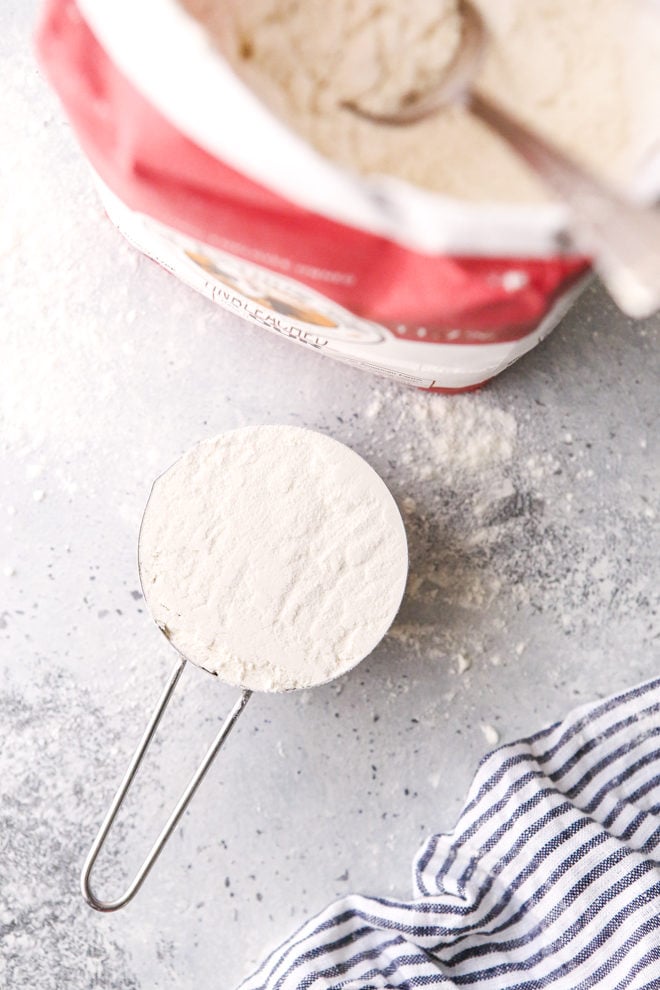
Is there a proper way to measure flour? Yes, definitely! And if you’re just dipping your measuring cup into a bag flour and scooping it out, I’m sorry to tell you that you’re doing it wrong.
Baking is a science, as we all know. If you change the proportions of ingredients, sometimes even just a little, things don’t turn out as well. One of the biggest mistakes I see people make in baking is measuring flour incorrectly, which can result in dry, dense or tough baked goods.
Let me show you the best way to measure flour and you’ll never make that mistake again!
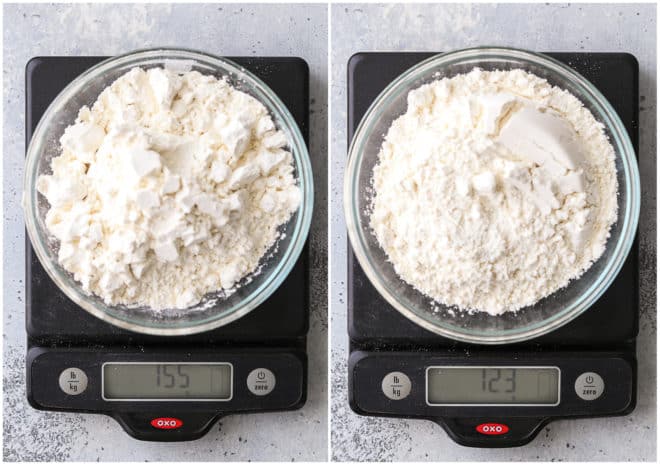
Right vs. Wrong Way to Measure Flour
Take a look at the photos above. Both images are of 1 cup of flour, the only difference is how it was measured. And look at how different the weight is!
The standard weight measurement for 1 cup of flour is 120 grams (I’ve gotten this number from King Arthur Flour, a baking source I trust a lot, though I have seen 125-130 grams listed on other sources). The most effective way to measure out 120 grams every time is to use a digital kitchen scale, but don’t worry if you don’t have one, a baking scale isn’t necessary.
The Wrong Way: In the photo above on the left, the flour was measured by dipping the measuring cup directly into my flour jar and leveling off the top. It came out to 155 grams, which is almost 1/3 cup additional flour! Imagine adding that to a cake or cookie recipe— it would not turn out the way it should.
The Right Way: In the photo above on the right, the flour was measured by the “spoon and sweep” method and it came out to 123 grams, which is pretty dang close! And it’s close enough that I’ll call it a success.
Let me show you how the “spoon and sweep” method works!
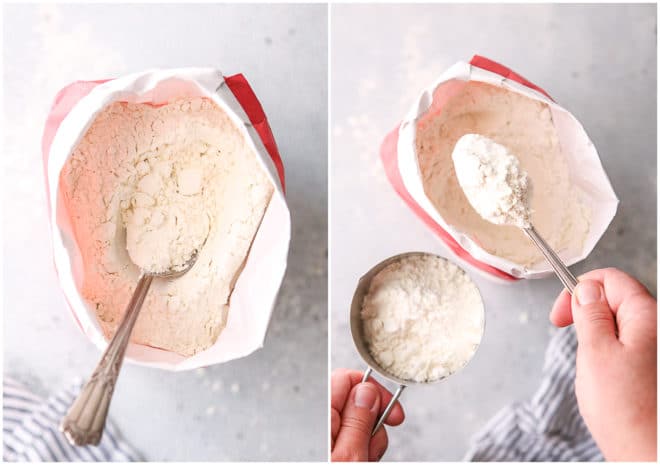
How to Measure Flour with the Spoon and Sweep Method
- Fluff the flour. Flour settles and compacts while it sits, so before you measure it, use a spoon or scoop to fluff and loosen it up a bit.
- Spoon flour into measuring cup. Add flour to your measuring cup one spoonful at a time.
- Fill until measuring cup is overflowing. Continue to add spoonfuls of flour until measuring cup is mounded on top.
- Sweep the top. Use a flat edge like a knife or your finger to sweep across the top of the measuring cup, letting the excess flour fall back into your flour bag or jar.
And there you have it, a nearly perfect cup of measured flour, ready to be turned into something delicious!
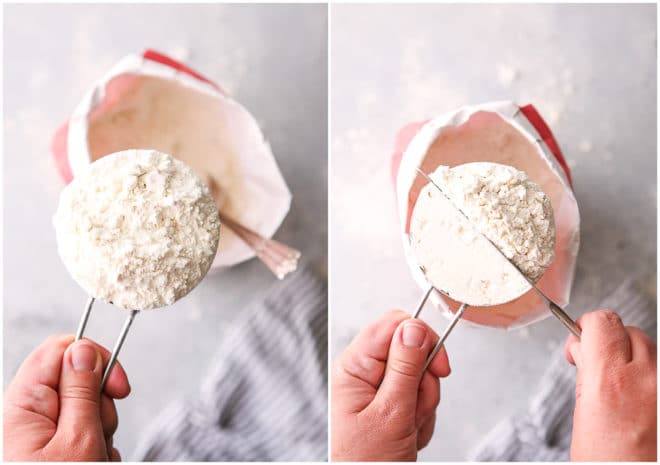
All of the recipes on this site are tested using the “spoon and sweep” method to measure flour. If a recipe from my site (and even from elsewhere) doesn’t turn out when you try it, it could be because you’re not measuring flour correctly. Give this method a try and see if it makes a difference!

More Baking Tips
If you found this post helpful, check out these other tips!
- How to Quickly Bring Butter to Room Temperature
- How to Separate Eggs
- Use Parchment Paper to Make Baking Easier
- Do Eggs Really Need to Be at Room Temperature?
Shop Baking Tools

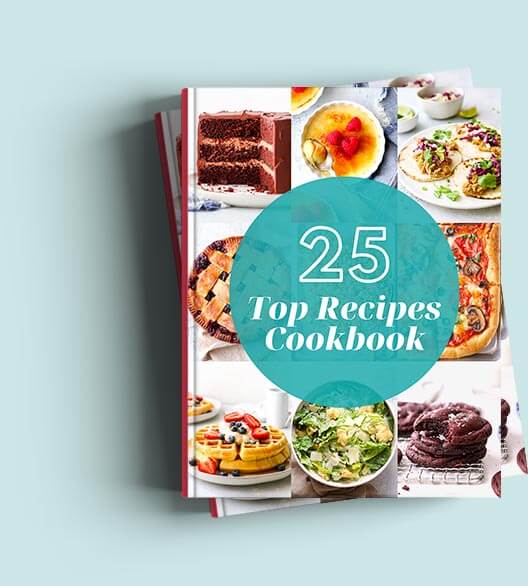
Great tip! Thanks for the info!
Yes, these are excellent tips! Lovely blog!
I will try this next time I bake!
Great photos! Those alone without the text will teach you how to measure a cup of flour properly.
Thanks!
What kind of scale would you recommend?
Definitely an important thing to know!
My personal recommendation for this method would be to use a measuring cup, as shown, by overfilling the cup, but then to follow by tapping a knife or spatula along the rim before dragging it across the top. This allows for every pocket of the cup to fill with flour, creating a much more accurate measurement.
Once you have your cup correctly measured out, i recommend verifying your weight with a scale. A cup of all-purpose should actually come out to weighing between 125-130g(imo 120g as you mention is quite inaccurate and if you google this you will find more people stating 1cup=130g).
By doing both steps, this assures you have a perfect amount of flour every time. Also, if your flour has happened to build up a little bit of moisture due to poor storage, than simply using the weight measurements, concludes in a false read due to the change of overall weight in the flour as a whole. By doing this, you can also end up saving the step of using a scale, for when you are following an imperial measurement recipe and don’t want to convert every ingredient, or take out the scale only for the flour.
I hope my extra pointers help.
Happy Baking!!
Thanks for all the baking tips, over time you forget the reasons for some or just forget so refreshing helps
Great tips for how to measure flour.
Blogger at https://thefireflygrill.com/
Proffessional Web development services Ahmedabadwith a focus on quality, efficiency and professionalism. Our development team has many years of industry experience and are experts in various programming languages and frameworks. We take care of all the boring details so you can focus on what makes your website great
thanku sir share this website visit my website and all service available
thanks for share sir website and good information
Love it but need help please